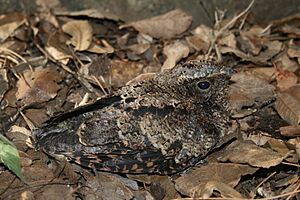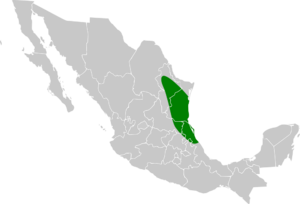Tawny-collared nightjar facts for kids
The tawny-collared nightjar is a special bird that lives only in Mexico. It's part of a bird family called nightjars, known for being active at night. This bird gets its name from the tawny (light brown) collar around its neck.
Quick facts for kids Tawny-collared nightjar |
|
|---|---|
 |
|
| Conservation status | |
| Scientific classification | |
| Genus: |
Antrostomus
|
| Species: |
salvini
|
 |
|
| Synonyms | |
|
Caprimulgus salvini |
|
Contents
About This Nightjar
Scientists group living things to understand them better. The tawny-collared nightjar was first named Caprimulgus salvini. Later, scientists decided it belonged in a different group called Antrostomus. This bird is unique and doesn't have different types or subspecies.
What Does It Look Like?
The tawny-collared nightjar is about 23 to 25.5 cm (9.1 to 10 in) long, which is about the size of a large robin. One female bird weighed about 56 g (2.0 oz), which is lighter than a tennis ball.
Colors and Markings
Male birds have dark brownish-black feathers on their upper body. Their head has dark spots, and their back has fine light brown speckles and dark streaks. The most special part is the wide, light brown or buff-colored collar around their neck, which gives them their name.
Their tail is dark brown with wide white tips on the outer feathers. Their wings are brown to dark brownish-black with light brown spots and stripes. The face is a dark reddish color with brown stripes.
Underneath the Bird
The chin and throat are dark brownish-black, with a thin white band just below the throat. The chest is dark brownish-black with small cinnamon-colored speckles. The belly and sides are dark brownish-black with many white spots.
Female Birds
Female tawny-collared nightjars look similar to males. However, the tips of their tail feathers have a narrow buff (light brown) band instead of a wide white one. The light brown markings on their wings are also paler, and the band on their lower throat is buffy instead of white.
Where Does It Live?
This nightjar lives in northeastern Mexico. You can find it from the states of Nuevo León and Tamaulipas south to Veracruz. Most of these birds stay in the same area all year. However, a few might move a bit further south during the non-breeding season.
Its Home
The tawny-collared nightjar likes dry or semi-dry places. This includes brushy woodlands, thorny forests, and thick scrublands. It avoids very wet areas or places with dense, humid forests. You can find these birds from sea level up to about 500 m (1,600 ft) high in the mountains.
How It Behaves
What It Eats
The tawny-collared nightjar is a nocturnal bird, meaning it is active at night. It hunts for flying insects. It often catches them by flying out from a perch, like a branch, or sometimes from the ground.
Reproduction and Life Cycle
The breeding season for the tawny-collared nightjar is from April to August. Female birds usually lay two eggs. Like many nightjars, they probably lay their eggs directly on the ground without building a nest.
Its Song
The song of the tawny-collared nightjar is described as a quick, sharp "chi-wihw" or "tchi-wheeu". It repeats this sound quickly. The bird usually sings from a hidden spot in a bush or tree. It sings mostly at dawn and dusk, and mainly from March through July.
Its Conservation Status
The IUCN (International Union for Conservation of Nature) has looked at the tawny-collared nightjar. They have decided it is a species of "Least Concern." This means that it is not currently in danger of disappearing. There are at least 50,000 adult birds, but their numbers are slowly going down. Still, scientists haven't found any big threats to the bird right now.


